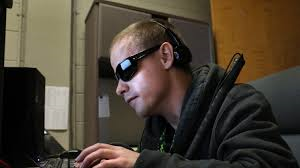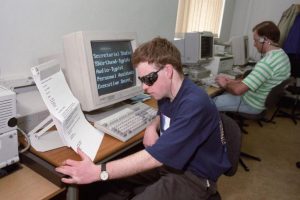The Blind Transcriptionist

It was one of those summers that you’d remember well into your dotage though possibly in the wistful, sepia toned way that distant memory has. I was living by the sea in a little cottage, visiting the beach every day, eating fish freshly caught by friends and taking long walks on cliff paths under a rich hot sun. I relied a lot on my friends during that summer because I was blind, still am in fact and it is a situation that requires patience, understanding and ingenuity to make relationships successful, including work. This is a sweet memory and, it might be that the more practical amongst you say, ‘Well, Ollie, how did you support yourself?’ The answer is, I was a transcriptionist. By night I would clamp on a pair of headphones, flex my fingers, place my bare and somewhat sandy feet on my trusty control pedal that was tucked in under my desk and transcribe audio conversations into the written word.
I was working for Fingertips Typing. As I recall, all communication was done via the internet and there was only one time I actually used my vocal cords to speak with Cathy Bennett, the captain of the Fingertips ship, and that was when I defaulted on a deadline due to young and foolish misadventure… sorry Cathy… Also, those who are considering me for future writing commissions, I’m far more reliable now…seriously!
So, how did I, as a person with no vision whatsoever, transcribe interviews, focus groups, business calls or any of the plethora of audio formats that Fingertips clients provided?

Desk Area
There are the basic tools that are required for any transcriptionist with just one supplement for a blind or visually impaired worker; a screen reader equipped computer, a pair of over the ear headphones, specialised software to play the audio file and a usb control pedal.
I use a screenreader called Voiceover which is available on all Apple computing products. A screenreader provides audio feedback of what is happening on the screen. In the simplest terms a synthetic voice provides verbal feedback when a key is pressed, describing what happens on the screen. When typing documents, such as this one, my screenreader is telling me each word as I complete it and, when I hit return, I’m told that I’m on a new line.
For the most part, a screenreader allows a blind or visually impaired person to use a computer just as well as a sighted counterpart, with some caveats which applied to my transcription work and which I will come back to later.
The headphones are important, I chose over the ear because they helped block out the distracting sounds of neighbours, barking dogs and ever squabbling sea gulls.
The specialised transcription software I recommend is Express Scribe which is completely compatible with screen readers.
The pedal, though not absolutely necessary, made the work so much easier as it allowed me to control the playback of the audio file with my grubby feet.

The Process
I can’t put this any more simply….transcription is playing an audio file and typing it down…it’s that simple…well, it’s not quite that simple.
The client who has sent in the audio file to be converted into nice clean words on a page needs to know who is talking, what is said and half said, what time people are saying certain things and so on. The format of this varies from transcription service to transcription service. Some use templates, some use very specific syntax, some are looser about the whole thing. Whatever the case, there will be an in house rulebook of how the transcription document is to be presented and, as any who have sight loss and are reading this blogpost will know, visual interfaces don’t translate perfectly into audio prompts….and here is that caveat I mentioned earlier, there are limitations. For example, it is difficult to understand formatting when a document is being read out as it doesn’t include the number of spaces between words or description of tabulation. Also homophones (words that sound the same but are spelled differently such as the classic there, their, they’re) are an issue when spell checking a document. This is why sighted support is often required during the tidying up process. The way around it? I spoke to Cathy and we worked out a system, it’s as simple as that. I’ve worked for a few transcription services over the years and this has always been true, they are willing to listen and, in the case of the wise ones who see value in their workers, they will work with the employee to overcome obstacles.
Working as a transcriptionist is very accessible to those with vision loss who have good computer literacy. The work can be done from home, in their own time and the workload (within reason) can be flexible and it is in a format that almost all visually impaired and blind people are comfortable with, audio.
As for people with other disabilities, transcription doesn’t end with audio. It can be transcribing someone’s notes into a digital format which is popular amongst authors who prefer a pen and paper approach to writing.
Home based work is also perfect for those with mobility issues or who need to remain at home.
My closing thought is this; If you are looking to change work or seeking work for the first time, working for a transcription service is rewarding and, depending on the audio files you receive, can be very interesting. Yes, there will be issues, there are issues in any working relationship due to a whole range of things from family responsibilities, gaps in knowledge or disability. It is essential that the employer and employee talk about these concerns because, ninety-nine times out of a hundred, there are solutions. So, if you are looking for interesting, flexible and accessible work, no matter who you are, why not give transcription a go?
